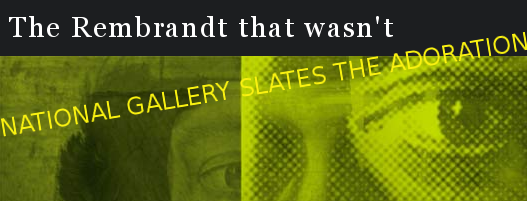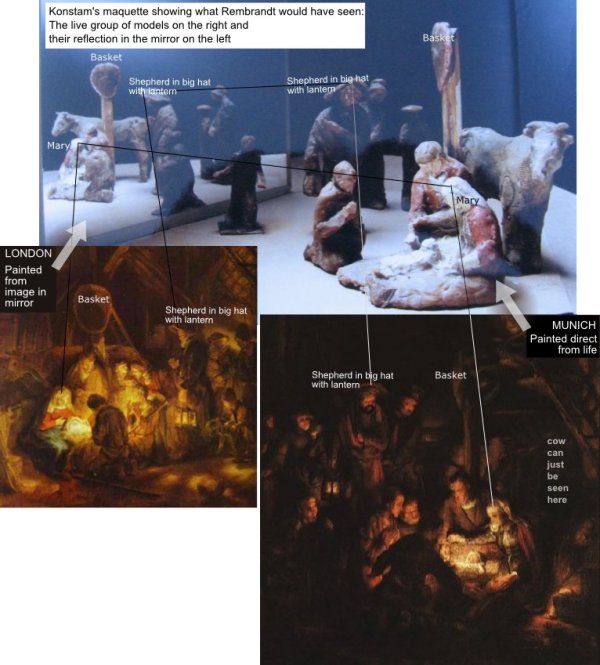The introduction to my talk at The Wallace Collection reads “Konstam’s discoveries have proved surprisingly controversial considering that they agree entirely with the documentary evidence of of Rembrandt’s own contemporaries and earlier connoisseurship. They are clear and obvious to the layman observer. It is today’s scholars that are out of step.”
There is a comic side to this article on The National Gallery’s version of “The Adoration of the Shepherds”. Written many years after Konstam’s Burlington article “Rembrandt’s Use of Models and Mirrors” in which he demonstrated several of the nearly 100 examples of Rembrandt’s use of mirrors he has found among Rembrandt’s drawings (excluding the self-portraits). Yet for the experts there is still “a puzzling relationship” between the two Adorations. This pair is an example in paint of Rembrandt’s proven practice in drawing.
For the record Konstam also intervened in the establishment’s presentation of the new scholarship at The Wallace Collection to tell them that the National Gallery version was almost an exact mirror image of the three dimensional group posing for Rembrandt in the Munich version. Furthermore, Rembrandt could have observed the reflection from the same position from which he observed the group directly.
Thus the Adoration pair are an extensive proof of Konstam’s original, findings tacitly ignored by all scholars since 1977. The geometry of space and the coincidence of the opening gesture of the shepherd’s arms from prayer found in both must surely lead us to return to the original attribution and conclude both paintings are by Rembrandt himself, and further to see the last 100 years of Rembrandt scholarship as a highly contagious, persistent and deluded episode that must now be abandoned with apologies all round.
See the video and collage below for just how accurately The National Gallery version reflects therefore reverses the Munich group.The live models remain fixed only the dog and the cow move.
The real puzzle that should concern the world at large is – how is it possible that so many educated people should be persuaded by ideas so much at odds with the documentary evidence and previous scholarship, on so little evidence and for so long?
Article - National Gallery Rejects The Adoration
Notable quote: "Other evidence also places the painting in Rembrandt’s studio. An X-radiograph of the Munich work shows that the shepherd kneeling by the manger and silhouetted against the light originally had his hands folded in prayer before his chest, as in the London version. But in the final painting Rembrandt changed the pose to one with outstretched hands. The artist who painted the variant (now in the National Gallery) must therefore have seen Rembrandt’s painting in the studio before this change was made."
The Adoration - two sides of the same coin?
Please watch this 5 minute video for the best explanation of Rembrandt's Adoration of the Shepherds (best in full screen)
There are two versions of The Adoration of the Shepherds, one in Munich and the second in the National Gallery (London). Both were once attributed to Rembrandt: The Munich version is still a Rembrandt. The London version has been de-attributed by the Rembrandt Research Project (RRP) in spite of the fact that the National Gallery experts examination of the materials confirmed that the painting was from Rembrandt's studio. The object of this demonstration is to prove that the London painting is truly a Rembrandt though the RRP insists that this version cannot possibly be by him.
On the right of the photograph you see a maquette made from the figures and architecture in the Munich painting, that Rembrandt observed and painted direct from life. A cow and a basket also form a part of the composition.
The reflected part of the photograph you see in the mirror (on the left) matches up with the subject matter of the London painting to such a degree that we cannot doubt that Rembrandt (or whoever else was painting from Rembrandt's precise position) painted what he saw in the mirror. As the use of a mirror can be demonstrated many times in Rembrandt's accepted drawings it is most rational to assume that Rembrandt stayed in the same position and painted both paintings; probably concurrently, with the same palette and brushes.
It is amusing to note that while the humans are static, only the cow moved: the hats of the figures remain the same, the basket on the post is seen in elevation in the Munich version and in plan in the London version, the lantern is still carried by the man with the broad brimmed hat, lots of tiny details are transmuted but most of all the infinitely complex space relationship between the figures remains constant.
By understanding the extreme complexity of the task of constructing the London subject from the Munich painting, we can be certain that a mirror was used.(This is no simple print image. It is a reversal of a new point of view of the same very complex, three dimensional group we see in the Munich painting.) From this understanding we not only regain a lost Rembrandt, we demonstrate that the impressionistic style of the London painting is also Rembrandt's. Thus widening the stylistic spectrum that has been imposed arbitrarily by the RRP.
Furthermore it is proved that Rembrandt worked from a theatrical-type production. I believe he set up live models dressed with costumes (mentioned in his inventory of 1656) in the adoration paintings, I believe the scene was staged in a barn. These tableaux-vivants, the very life's blood of Rembrandt's work as artist and teacher, are implicitly denied by the RRP and their followers, who are keepers of Rembrandt drawings in the museums: a fundamental error, which invalidates many of the experts' judgements over the last 100 years.
***************
Two legitimate questions may arise from this demonstration. 1. Did mirrors of this size exist in Rembrandt's time? Answer: not made from one sheet of glass, this large mirror was probably made of polished metal. And 2. Why should he work from an inadequate reflection of his models when he had a group to observe direct from life? Answer: Rembrandt was not alone in the barn. There are student versions of this same scene, both drawn and painted, that show that students were working side by side with the master, each with their own individual viewpoint. This would have inhibited Rembrandt's freedom to move himself or change the group of models. Alternatively, it may just be Rembrandt's explorative spirit that drove him to this single experiment, which he never repeated in painting, but many times while drawing.
***************
If you have doubts please look at the rest of this website before submitting your questions.
It is my belief that the other end of the spectrum of style in Rembrandt's paintings should also be redefined by testing a painting in The Wallace Collection: The Uncharitable Servant. This painting was once the most highly valued Rembrandt in the world. It has been described as Rembrandt at the extreme limits of his ability, it is not typical of Rembrandt but Rembrandt is a most varied artist and we need to define the outer limits of his variability as precisely as possible. If The Uncharitable Servant, was put through autoradiographic tests this would show us the way the painting had been built up right from the original drawing on canvas, thus establishing a clear attribution. The result of this could be to re-inflate Rembrandt's oeuvres and reputation back to where they both stood 50 years ago. If the London painting turns out not to be a Rembrandt the case for widening the spectrum towards a loose impressionistic style remains imperative.


